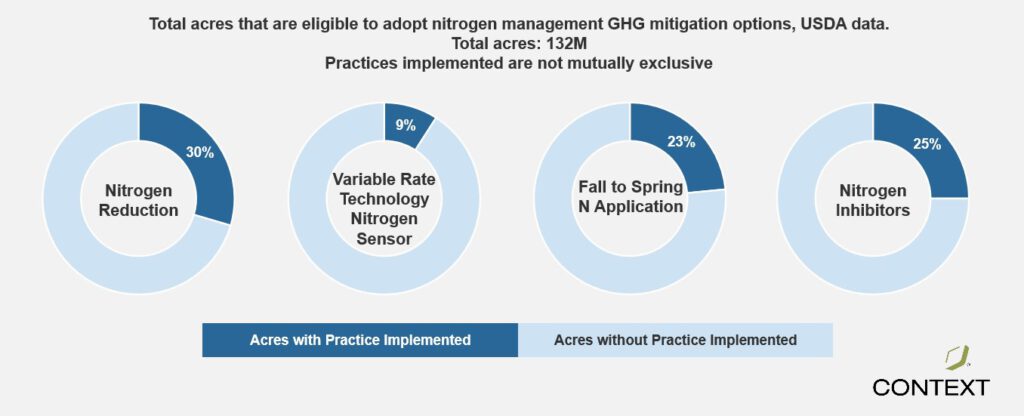How Does Changing Nitrogen Management Impact Farm Greenhouse Gas Emissions?
Content has been adapted from The Context Network “Get Smart, Stay Smart” Ag Carbon Service.
The short answer: Making small tweaks to on-farm nitrogen use can make a big difference in greenhouse gas emissions, water quality, and crop production.
Break it down: Nitrogen is a key nutrient for crop growth and production. But nitrogen not taken up by crops does not necessarily remain in the soil.
- Excess nitrogen can move into waterways, creating algal blooms and decreasing water quality.
- Nitrous oxide—a greenhouse gas 300 times more potent than carbon dioxide—can also be produced by any excess nitrogen fertilizer.

Figure provided by the Context Network, LLC. Data from the USDA White Paper, “Managing Agricultural Land for Greenhouse Gas Mitigation within the United States.”
There are tried-and-true methods for more precisely matching nitrogen application to crop needs. In fact, nutrient management often follows the “4R strategy”—the right source, right rate, right place, and right time. In fact, a quick search for extension information in your area is a great source for planning your nutrient management strategy.
- Rate: Decreasing the amount of nitrogen applied to crops can prevent excess nitrogen in the soil. According to USDA data from 2016, 39 million acres of farmland in the U.S. are candidates for reducing nitrogen application rates.
- Timing: Applying nutrients at the right time for both crop growth and pollution reduction is key. Switching from applying nitrogen in the fall to application in the spring can prevent nutrient loss over the winter. 31 million acres in the U.S. are good candidates for this tactic.
- Method: The way in which you apply nitrogen matters. Using “Variable Rate Technology” (VRT), farmers can more precisely apply nitrogen at different rates in different parts of the field, applying more nitrogen where needed and less where it will not affect yields.
- Technology: Using nitrogen fertilizers that contain nitrogen inhibitors helps control how quickly nitrogen fertilizers are converted into forms of nitrogen that can pollute water and air—ammonia, ammonium, nitric oxide, and nitrous oxide. For fertilizer applied within 30 days of planting, using formulas with nitrogen inhibitors can help prevent excess greenhouse gas emissions.
It’s all about priorities. With fertilizer prices at a premium, optimizing your on-farm nitrogen isn’t just good for the environment—it’s good for your pocketbook, too.
Photo by Edwin Remsberg and courtesy of USDA-SARE.








